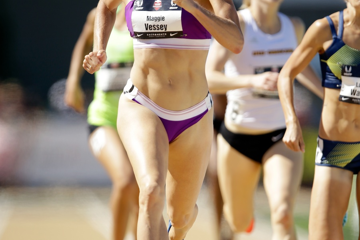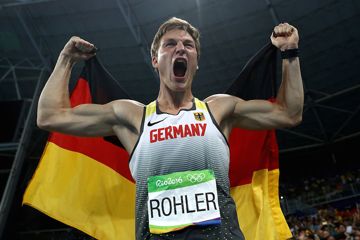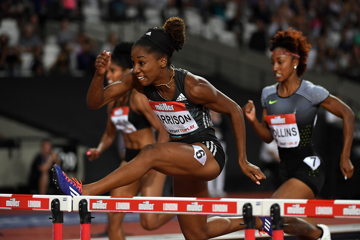Pamela Dutkiewicz at the European Indoor Championships (© Getty Images)
If you’re more worried about the fit of your outfit than the hurdles on the track in front of you, you’re bound to trip up. Olympic hurdler Pamela Dutkiewicz writes about how she left her body insecurities behind.
Both of my parents are athletes. Dad’s a footballer, mum an 800m runner. I’ve been active for as long as I can remember. When I was 14 or 15, when puberty hit, I started to get some curves. But that was fine. At the age of 16 or 17, that’s when weight first became an issue.
I moved from Kassel to Bochum to attend a sports boarding school. From then on, I was eating whatever was served in the school canteen. It was tasty, but incredibly fatty and nothing of nutritional value – and this was at a high performance centre.
I started to notice I was putting on weight and I began to feel uncomfortable. We all know the kind of outfits we wear in athletics: tiny briefs and tight tops.
One thing I’ll never forget is how I would stretch my tight shorts over the back of a chair the night before a competition so the material would widen and wouldn’t cut into my hips as much. In practice I’d wear a top underneath my t-shirt so it wouldn’t stick to my body. I’d be sweating like hell and it was exhausting trying to keep up.
I felt insecure and, on top of that, I felt like no one would take me seriously – especially not my competitors. In the sprints body language is everything. What’s your demeanour? How do you present yourself? I don’t think I looked particularly competitive back then.
“The chubby one”
Listening to those around me, my weight was the source of all of my problems. “Of course you didn’t run faster than that, you’re too heavy,” would be the universal answer. I once overheard one of the coaching staff describe me as ‘the chubby one’. That was incredibly hurtful and is still engraved in my mind to this day. I know several other younger girls who experienced similar problems. People would joke about them, which meant they probably talked about me in the same way.
But at least I was pretty good. I was a top junior hurdler in Germany, won medals at national championships – in 2010 I was one of the fastest U20 hurdlers in the world.
So yes, I’d always be up there. Yet the thought of a photo of me appearing in a newspaper would scare the living daylight out of me. It was all I could think about in the days following a competition: which photo would they choose? To stand at the starting line of a race and be concerned about which parts of my body were visible took all my focus away from the race. It was all I would think about: in my spare time, during training – and in competition when it’s really no use at all.
No one on the team knew how to deal with my situation, so they’d weigh me over and over again, documenting every kilo. It was incredibly humiliating. I was so embarrassed.
“An apple a day...” won’t keep the doctor away
I began to eat very inconsistently. I’d know for example that I’d be weighed on a Wednesday, so automatically I wouldn’t eat all day and hardly drink anything. At the time I didn’t really think about it, but of course this kind of diet isn’t exactly benefitting your performance. I know it was anything but a ‘healthy diet’, overall I hardly ate any junk food, but I would have sudden cravings.
Once one of the staff told me: “Just have an apple and drink tea for the rest of the day.” Knowing what I do today, I can’t believe anyone would pass on this kind of advice to an athlete. Back then I would do exactly as told: eat one apple a day and stick with tea for the rest of the day. I wasn’t questioning it. In the sprints, every extra kilo will show in tenths and hundredths of a second.
After half a year of inconsistent eating, I started working with one of the federation’s nutritionists for a year. I was following the meal plans meticulously. Absolutely nothing changed. Then I started working with a supplements company. The nutrition coach thought my irregular diet had created hunger phases, so the idea was to fill those gaps with three main meals and two snacks. That way my blood sugar levels would remain even. That meant I’d sometimes be eating when I wasn’t even hungry. The first six months looked promising, then my weight stalled again. I came to the conclusion that if not even nutritionists could help me, I’d never be able to lose weight.
In February 2015 I felt in the shape of my life. I’d already clocked the qualifier for the European Indoor Championships and took silver at the German indoor champs. Then, during my cool-down, I rolled my ankles awkwardly and tore pretty much all the ligaments in both my ankles. That was it. I remember a photo of me lying on the track, too many extra kilos… that image is burnt into my mind.
The injury turned out a blessing in disguise – I finally had time to look after myself.
An unexpected six months to myself meant time to experiment. Normally I’d jump from one season right into the next so as not to spoil any of the previous work I’d put in.
I prescribed myself a thorough check-up. At a clinic in Bochum they checked everything – from hormones to thyroids – much more detailed than I’d ever been looked at before. Two days later the results arrived: everything was absolutely fine with me. I was devastated. Yet another broken straw I’d clung to. There was no explanation for my stagnating weight.
The doctor must have sensed my despair and put me in touch with Mark Warnecke, a former swimmer. He’s now a physician and together with some nutritionists founded a company. That was the turning point for me.
“You've been fattening yourself up”
I met Mark and nutritionist Dr. Heinze and told them my story. I can remember the exact words Dr. Heinze used: “You clearly have an understanding of food and your own body. The contents of your diet are great, but if I’m honest, you’ve basically been fattening yourself up.”
His words hit me like a bullet. “You’ve been fattening yourself up.”
He explained to me that – just like Mark Warnecke – I’m someone who doesn’t need a lot of calories to recover. His recommendation was to continue eating exactly the same things I was already eating, but to cut down from five to three meals a day and eat whatever I felt like having for breakfast. I gave it a go and the results were remarkable. And more importantly, I hadn’t felt this good in years. The relief in pressure – on both body and mind – was huge.
I could see changes in my body every week. I never thought you’d be able to see abs on my body. Now I am confident when I am standing on the track. Back in the day my focus was on anything but the track – 1000 distractions. What is she wearing? How do these briefs fit? What to wear underneath? Now I stand on the track and focus on the hurdles in front of me, the hurdles that matter.
I’ve lost 10 kilograms since I made those changes – without starving myself or dieting. Meanwhile, I gained an incredible amount of knowledge, confidence in and understanding of my body. I think many girls, especially going through puberty, have similar experiences. Your body changes and you lack in confidence, but in the end – and I know this sounds corny – persistence pays off. It takes a lot of stamina to continue pursuing your dreams until you finally can reap the rewards.
The Pam you see now is a completely different Pam than the one you saw a few years ago. It took me a long time to defeat my demons: nine years to be precise, but I’ve left them all behind me sitting in the blocks.
This blog first appeared in German on Wortathleten.de under the title Der Kampf mit meinem Körper.








